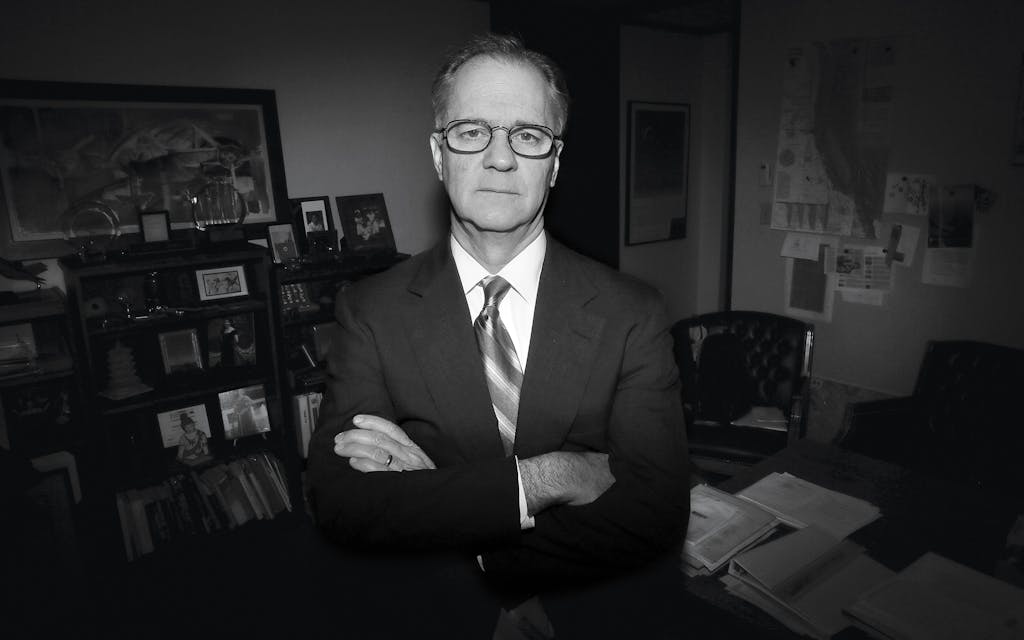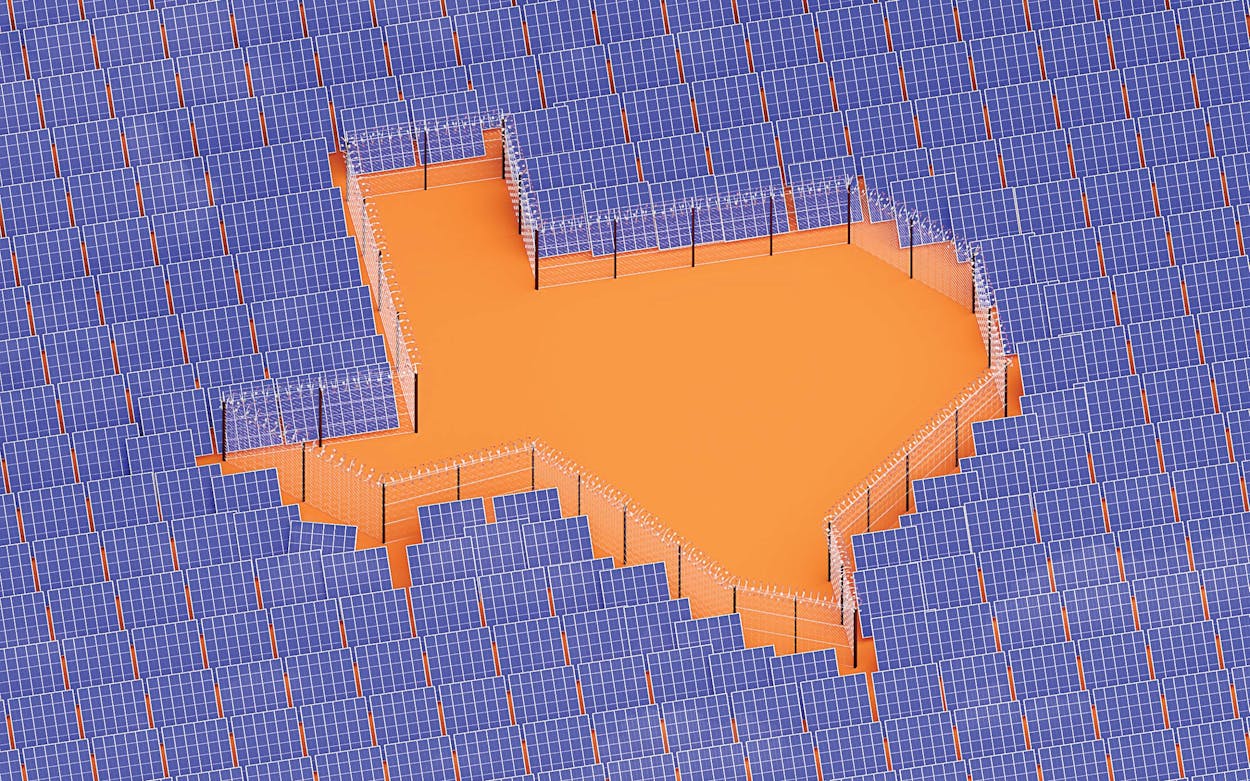At last count, Texas boasted 214 wind farms and 111 solar farms. Dozens more are under construction and hundreds more under consideration. Those in operation generate, on average, about a quarter of the state’s electricity—up from 7 percent just a decade ago. Both wind and solar set new electrical output records this year. Solar in particular emerged as a breakout star in preventing blackouts this summer.
So, after Texas leaders created an advisory committee last year and charged it with devising a “comprehensive state energy plan” to fix what ails the power grid, you might reasonably expect that renewable energy interests would have been well represented. You would be wrong. Not only that, but the only committee member with significant experience in renewable energy raised ideas that veer into the realm of conspiracy theory.
Patrick Jenevein, a 64-year-old Dallas businessman, introduced himself to a Texas Senate committee in 2021 as a U.S. defense contractor and former wind-farm developer with “over a quarter of a century working with the Communist Party’s biggest defense contractor in China.” Lieutenant Governor Dan Patrick looked at Jenevein’s CV and decided he was the right person to help plot the future of electricity in Texas, as a member of the State Energy Plan Advisory Committee.
In June, the committee heard from more than twenty witnesses, including the head of the Texas Oil and Gas Association, but none specializing in renewable energy generation, according to the Dallas Morning News. Attendees of the meeting told me that Jenevein asked whether renewable energy development was contributing to changes to the earth’s magnetic field. (“No way,” said Patricia Reiff, a professor of physics and astronomy at Rice University.)
The question was met with uncomfortable silence by the expert witnesses, a pair of top executives of the Texas power grid and a meteorologist. (Jenevein acknowledged asking about magnetic north but denied drawing a connection to renewables.) At the committee’s second meeting, in early August, Jenevein asked a variation: Could extracting energy from the wind cause unknown problems, and could climate change be related to changes in the earth’s magnetic field?
In a subsequent interview with Texas Monthly, Jenevein speculated that the culprit behind global climate change could be plate tectonics, the shifting of continent-size pieces of the earth’s rocky outer shell. “If we determine that tectonic movement is a much bigger contributor to climate change than carbon dioxide, I worry that a future administration might say, ‘Hey, this was crazy—the CO₂ emissions were not the problem people thought they would be, and we need to do a one-eighty on energy policy,’ ” he told me. (In 2021 the United Nations’ Intergovernmental Panel on Climate Change released a 1,782-page report detailing the latest scientific understanding of the causes of climate change. “On longer time scales, orbital effects and plate tectonics also play a role,” it notes in its only significant mention of plate tectonics. CO₂ is mentioned 3,243 times.)
Jenevein said his company, Tang Energy Group, built some gas-powered plants in China from the mid-nineties to the late 2010s and one of its subsidiaries produced wind turbine blades in partnership with a large Chinese defense contractor. In Texas, he helped develop a small, ten-
megawatt wind farm to provide power to a cottonseed mill in Lubbock. He told me he also worked as a development consultant and investor on a couple of other wind farms.

He had hoped to become a major renewable energy developer, using Chinese equipment, in partnership with the same state-owned defense contractor. The effort appears to have generated more lawyers’ fees than megawatts. Jenevein got into a dispute with his partner, Aviation Industry Corporation of China, over an alleged breach of contract. The sides entered arbitration but ended up in federal court in Dallas. Jenevein and his fellow investors were awarded $62.9 million.
If Jenevein had successfully developed those wind farms, China would have established a major beachhead in the Texas power grid. In 2021 the Legislature passed the Lone Star Infrastructure Protection Act, a bill to protect the state’s critical infrastructure, including the power grid, from incursions by potentially hostile foreign nations, including China. Jenevein testified in support of the legislation.
Why wasn’t there at least one member of the state’s future-of-the-grid committee with experience building large, two-hundred-plus-megawatt wind farms in West Texas? Texas Monthly tried to pose that question and others to Patrick, but he didn’t return emails or phone calls. The renewables industry has invested more than $80 billion in Texas, according to American Clean Power, a lobbying group that represents clean energy companies. More than 42,000 Texans are employed in clean-electricity generation, according to the group, and the passage of the Inflation Reduction Act could more than double the size of the renewables workforce nationally by 2030.
“More than a quarter of the state’s power comes from renewable energy, and it is such a key to keeping costs down,” said Jeff Clark, president of the Advanced Power Alliance, which is based in Austin and lobbies in Texas and other states for power grids underpinned by a mix of natural gas and renewables. “We ought to be in the room.”
Governor Greg Abbott, Patrick, and Texas House Speaker Dade Phelan each appointed four members to the State Energy Plan Advisory Committee. There were no requirements regarding representation in the law that created the committee during the most recent legislative session, and the exclusion of renewable-energy developers was noteworthy, especially considering whom the state leaders did appoint.
The largest bloc of the twelve-member committee was composed of four executives at utilities or cooperatives, including the panel’s chairman, Phil Wilson, general manager of the Lower Colorado River Authority. Apache, ConocoPhillips, and Pioneer Natural Resources—all large producers of oil and gas—each have an executive on the committee. There was also a representative from NRG, one of the largest owners of natural gas–fired power plants in Texas. Other members included a businessman with experience in energy investments, a former gas turbine executive, and a former director of the state’s power grid.
At least seven of the members have made significant political contributions over the past decade to leading Texas politicians. For instance, Wilson gave $4,500 to Abbott and $3,500 to Patrick. Wendy King, a ConocoPhillips executive, gave $6,000 directly to Abbott and nearly $50,000 to a Conoco political action committee that funneled contributions to Abbott ($70,000), Patrick ($10,000), and Phelan ($2,750). Daniel Hall, a vice president at Oncor Electric, which keeps the lights on throughout North Texas, gave $17,727 to the Oncor PAC, whose top recipients include Abbott, Patrick, and Phelan.
Given the makeup of the committee, it was no surprise when its final report—released at the beginning of September—called for more gas storage and for wind and solar operators to invest in batteries or other technology to ensure their power supplies are more reliably available on demand. The Public Utility Commission of Texas will issue its own recommendations later this year, but the Legislature will ultimately decide what shape the market takes during next year’s session.
To understand what that might look like, it helps to go back to February 2021, when the state’s power grid and deregulated electricity marketplace both failed. About seven hundred Texans died in the freezing temperatures, and millions more were left shivering in the dark for days. The blackout was caused by a severe winter storm across the middle of the country, from the Canadian border to the Rio Grande. Several states faced the same extremely cold conditions, but only Texas suffered a crippling blackout, because it hadn’t winterized its natural gas facilities. While it is true that coal plants, nuclear plants, and wind farms all struggled, frozen natural gas pipelines and gas-burning plants were by far the biggest problem.
Yet as soon as the grid failed, Abbott deflected blame for the blackout onto renewable energy. He told Fox News, “Our wind and solar got shut down, and they were collectively more than ten percent of our power grid, and that thrust Texas into a situation where it was lacking power on a statewide basis.” The governor and other Republican leaders have kept repeating the same mantra ever since: renewables aren’t dependable. This claim appears aimed at distracting public attention from the Legislature’s continued failure to require the winterization of natural gas facilities. (In late August, the state finally took steps to address that risk, but it remains to be seen if the new regulations have any bite.)
By instead blaming renewables, Abbott created a political opening, and in stepped NRG and Exelon, two large power companies. Between them, they own twelve gas-fired and two coal-fired power plants, plus a large stake in a nuclear plant. They proposed an overhaul of the state’s electricity market that would pay coal and gas plants to sit idle but remain ready in case of an emergency. The same facilities that failed during the 2021 blackout would receive a windfall. “This is like giving someone a raise for failing to show up for work,” complained the Texas Association of Manufacturers in a December 2021 letter to Abbott and PUC commissioners.
Then, the PUC reportedly hired the firm that wrote the NRG-Exelon proposal, California-based Energy + Environmental Economics, to help it study the options for its upcoming proposal to the Legislature on redesigning the electricity market.
If the NRG-Exelon plan comes to pass, the wind-and-solar building boom in Texas, which has helped keep electricity prices low, could slow significantly. The Texas grid would be even more reliant on natural gas, which costs about twice as much as it did a year ago, thanks to greater global demand from Europeans cutting ties with Russian energy supplies after the invasion of Ukraine. The monthly energy bills of Texans—already rising to pay for the financial fallout of the 2021 blackout—could increase even more.
Wind and solar companies find themselves on the outside looking in as the future of Texas energy is decided. That’s a shame, because anyone who’s been paying attention in recent years can see that the state possesses a unique opportunity to lead in the creation of renewable power technologies and jobs. Instead, Texas leaders choose to strengthen their embrace of fossil fuels while campaign donations from that industry keep coming. As author and activist Upton Sinclair wrote in the thirties, “It is difficult to get a man to understand something when his salary depends upon his not understanding it.”
This story appeared in the October 2022 issue of Texas Monthly with the headline “Shutting Renewables Out.” An abbreviated version originally published online on August 18, 2022, and has since been updated. Subscribe today.
Correction: This story has been updated to reflect that outages at natural gas-burning plants were one of most significant contributors to the February 2021 blackout.
- More About:
- Politics & Policy
- Energy
- Wind Power
- Dan Patrick









